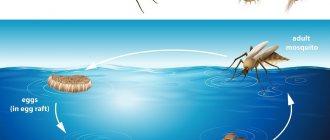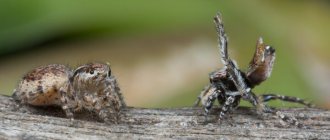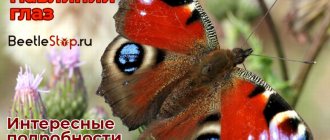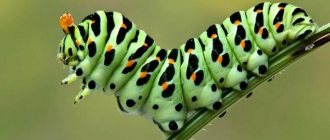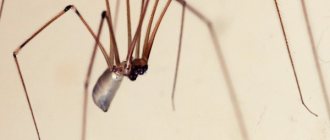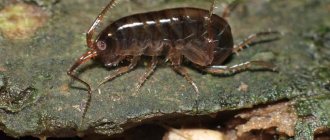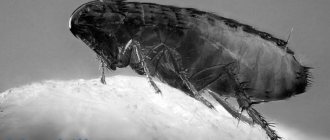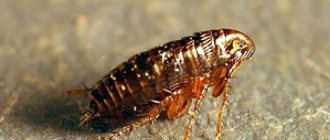According to their external features, spiders are classified as arthropods, just like crustaceans and insects. In the next gradation, the class of arachnids, spiders are the most numerous order. In addition to them, arachnids include about 10 more orders, including scorpions, ticks, and haymakers. Spiders are widespread everywhere, except on eternal ice. How do spiders living in harsh climate zones winter?
- Where do spiders go in winter? Rare species live in burrows and crevices
- Silverback spiders build their winter cocoons underwater
- Hiding in a mollusk shell
- They overwinter with young offspring (the female is eaten in the spring)
Where do spiders go in winter?
Arthropods adapt to the onset of cold weather in different ways. Spiders are unable to tolerate temperatures below 0 degrees due to tissue crystallization. Depending on this, spiders can sleep or die in winter.
Young cross spiders and “newborn” wasp spiders migrate on wind-blown spider webs in search of habitat on warm September days. Huddled in a crack in the bark of a tree, spiders sleep in winter.
Sexually mature parents of baby wasps end their life in the summer: the male - in the form of a “wife” dinner after mating, the female - after laying eggs. A similar situation occurs in adult crosses. Autumn is the mating season, when males go in search of females sitting in their web. After fertilization of the female, the male dies. The spider weaves a cocoon in which it lays eggs. Having hidden it in a secluded place (in the bark of trees, cracks in masonry), it also dies. In the spring, spiderlings emerge from the eggs, ready to weave webs.
Males and females of black widows do not survive until the cold weather. At the end of June, mating occurs, after which the female eats the “suitor”. Having laid up to 130 eggs in prepared cocoons, she hides them in lairs (mouse holes, crevices) entwined with dense cobwebs and dies. Spiders appear in September and live in a cocoon until April, eating each other. With the onset of stable heat, they go outside.
As for the species of black widows, spiders that were born in September spend the winter with them. In a warm cocoon left by a caring spider mother, they sleep until April. Spreading in search of habitats, they have arachnoid and venom-carrying apparatus. During mating at the end of June, the female karakurt eats the male. After laying eggs it dies.
Domestic arthropods may go into torpor with the onset of winter if the number of indoor parasites decreases sharply. Waking up before the onset of spring, they can feed on their relatives.
Rare species live in burrows and crevices
Predatory arthropods, whose life cycle exceeds a year, fall into torpor with the onset of cold weather. Species such as tarantulas live in the wild for 5 to 10 years. Helping them survive is the ability to go without food for a long time and the mild climate in their habitats. With the onset of cold weather, they burrow into their vertical burrows and hibernate until spring.
The edge hunter has a life expectancy of 2 years, until the age of mating. After breeding, they die in August. Immature individuals spend two winters in the mother's cocoon, attached to the grass on the shore, in a state of torpor.
Silverback spiders build their winter cocoons underwater
During the cold season, when rivers and lakes are frozen, the silverfish prepares winter housing. The spider controls the volume of the bell and the oxygen content in it. The air supply in such a cocoon is enough for 4-5 months. Nearby, the silverfish weaves the second and third mesh networks and fills them with air. This insurance allows you to overwinter without rising to the surface until warm days arrive.
Hiding in a mollusk shell
If there is no algae and nowhere to go, the water spider can use an abandoned mollusk shell instead of a cocoon. He fills it with air bubbles from the surface and covers it with thick nets instead of curtains. Such a house serves as reliable protection from large fish and crayfish.
They overwinter with young offspring (the female is eaten in the spring)
The black fathead spends its winter in a special way. With the onset of autumn, the mating period approaches, and the males go in search of females. Having carried out the necessary fertilization ritual, the male remains to live in the same burrow with the female. The fathead spider makes a cocoon for its offspring, where it soon lays eggs.
For 2 months, spiders guard the clutch in a cocoon. With the onset of spring, spiders appear. Spiders serve as food for them. By the end of summer there are 3 molts. Young spiders crawl out of their holes to find a home. After 2 moults they will become sexually mature and will look for a female. A male spider, whose life cycle is less than a year, dies by this time.
Spiders sleep in winter
Most spiders have a lifespan of less than one year. In cold weather, spiders usually die because they cannot live in such a climate. However, some types of insects are able to survive even winter. Thus, most spiders hibernate during the winter. But there are also exceptions.
Such exceptions include the South Russian tarantula. This type of winter spider crawls into its burrow and clogs the entrance with earth. The spider crawls out of its home only when it wants to eat. If the South Russian tarantula gets into a warm room next to a person’s home, then it can lead a normal life all winter. But this behavior is typical only for the South Russian tarantula. All other spiders that endure winter climb into their burrows at this time and fall asleep until the onset of warm seasons.
Are spiders insects?
This misconception can be considered the most popular. But it seems like the truth, doesn’t it? Spiders are tiny, often dark-colored creatures that crawl on their little legs. Spiders do not have a backbone, like many insects. And they seem to have an innate ability to end up where they are least expected.
However, spiders and other arachnids are still different from insects, which is why they ended up in a different category. Insects are characterized by a three-part structure: head, thorax and abdomen. Spiders, in turn, have a two-part structure: a cephalothorax - a solid head and chest, hidden in a hard shell, and an abdominal cavity. They do not have insect-like antennae and have one more pair of legs.
South Russian tarantula
Even children know this: the main feature of almost all types of spiders is the ability to weave a strong web, which can be compared to a fisherman’s fishing net. The web is secreted from the arachnoid glands and is similar in composition to silk.
Today, about thirty thousand species of spiders are known. Many of them have a very painful bite, and the bite of some can even be fatal. The name of the spider class Arachnoidea comes from the ancient Greek word “arachne”, which means “spider”. In this case, one cannot help but turn to ancient Greek mythology: one of the legends tells about the girl Arachne, an excellent weaver, who once decided to compete with the goddess Athena in her skill. Having weaved the best fabric, Arachne won the competition and thereby incurred the wrath of the goddess. Athena turned the girl into a spider, saying that from that moment on, she, as well as her entire family, would weave for the rest of their lives.
The body of arachnids consists of the following parts: the cephalothorax is the first part, which is the head and chest fused together. Eight small legs grow from the cephalothorax. The second part is the abdomen, in which the genitals are located, as well as the digestive organs, glands for secreting webs, with the help of which spiders weave their webs. Spiders differ from other arthropods in their characteristic features, here are some interesting facts:
Each spider has four pairs of legs, and each leg has six joints. Thus, each spider has forty-eight legs.
Spiders of central Russia
This region has several names at once, so the spiders of the Black Earth Region or the Middle Zone are two names of the same group. The range of these arthropods also extends to Eastern and Central Europe in the west and up to Murmansk in the north. All of the above groups may live north or south of the Central Region.
Spiders of Russia
Spiders of northwestern Russia also belong to the above groups. Among the arthropods living in the central region, we can distinguish the silver spider and the Heiracanthium.
On a note!
The water-dwelling silverfish is distinguished by the fact that it is the only truly poisonous northern spider. Since its habitat is stagnant bodies of water, it has little contact with humans and its bites are rare.
Heiracanthium is a yellow spider whose main habitat used to be the more southern regions of Eurasia. Its Asian name is sak. The bite of this arthropod is quite painful, but not life-threatening to humans. Due to global warming or increased traffic flows, heiracanthium began to spread northward. In Karelia, a spider was found on the shores of Lake Onega.
In areas with a significant number of bodies of water: Karelia, Leningrad region, forests of the Moscow region and others, you can find knitting spiders. These arthropods choose their place of residence near water bodies, since their food is long-legged mosquitoes. Knitters' nets are circular in shape with large holes between the catching threads. Animals are completely harmless.
What do they eat in winter?
Most spiders cannot eat their food right away. The venomous bite is necessary to paralyze the victim and turn its insides into a nutritional cocktail. The peculiarity of spider physiology does not require maintaining a constant temperature. For this reason, they can go without food for a long time and fall asleep, falling into torpor. During the winter months, the food supply is maintained by water and house spiders.
What do house spiders eat in an apartment in winter? Flies and mosquitoes stop penetrating into human housing with the onset of cold weather, going into hibernation. But apartments can be inhabited by cockroaches, moths, and fruit flies. Predators eat each other, thus redistributing habitat areas. The life cycle of house spiders is short: from 2 to 6 months. Reproduction depends on the food supply: if it is insufficient, new offspring appear after the end of the life cycle of the parents.
Eating in a natural environment
The spider's menu consists of 90% animal food, 10% plant food. The basis of the diet is various insects, which the predator can easily cope with. Large arachnids skillfully cope with reptiles, amphibians, and small rodents. Spiders that live in aquatic environments feed on fry, beetle larvae, and crustaceans.
What spiders eat depends on where they live. Large specimens attack anything living they can handle. These are often creatures several times the size of the predator, but the spider wins.
What can a small, medium-sized spider eat:
Large spiders eat, in addition to insects:
- small birds, chicks;
- snakes;
- vipers;
- snake;
- lizards;
- frogs;
- toads;
- fish;
- smaller relatives, males of the same species as the female.
mice, rats;
It is impossible to say for sure how long a spider can live without food in the wild. Experts say - more than a month. After a satisfying meal, the arthropod will want to eat again after 7-10 days.
One of the most beautiful representatives of arachnids, the tarantula can eat birds, but bird meat is not included in the main diet. Such food is difficult to digest and very heavy. Prefers insects, their relatives.
Arthropods of the steppe regions
Among the spiders in southern Russia there are truly poisonous species, the bite of which can lead to death:
- karakurts;
- funeral;
- black eresus;
- Steatodes.
Regarding Russia, the cellar spider is a spider that lives in the Crimea and the Caucasus. Although the distribution area of this animal is much wider, its main habitat is to the west.
Eresus
Black eresus (black fathead) is an inhabitant of the steppes. It can be found among the spiders of the Volga region, Tatarstan, and Kalmykia. Recently discovered in Crimea. A spider bite is painful.
Interesting!
The spider has a red abdomen with black dots, which is why it received the popular name “ladybug spider.” But only males have this color. Females are completely black.
Spiders of Russia
Karakurt
Karakurt is not the largest spider in Russia, but it is the most dangerous fart in the Russian expanses. Contrary to the cliché that these animals are found in the Karakum Desert, in fact their range is much wider. Karakurts are found among the spiders of Crimea, Tatarstan, Stavropol Territory and other relatively warm regions. The range is limited to the steppe zone. In colder forest areas, karakurts do not take root, although the spider was also found in the Altai Territory. But with a high degree of probability he got there by accident with the help of a person and is unlikely to survive the winter.
On a note!
All types of karakurts are black spiders. They may have red or white spots on the abdomen, but the cephalothorax and paws are always black. The only exception is the white karakurt.
Steatoda
The arthropod is very similar to the karakurt in body shape and color. Because of this, it received the name “false karakurt”. The habitat of arthropods is almost identical. They can be found among the spiders of Kalmykia, Tatarstan, Kazakhstan, and Crimea.
On a note!
It is possible that steatoda was actually found in the Altai Territory, since it is more cold-resistant.
Less poisonous ones include:
- South Russian tarantula;
- argiope;
- atipus wall.
Atipus wall lives only in one region - in Saratov, and is listed in the Red Book as a rare species.
South Russian tarantula
This nocturnal spider has a very large distribution area. The habitat area of the South Russian tarantula includes all steppe regions of Russia and surrounding countries:
- Southern Ukraine;
- Crimea;
- Caucasus;
- Steppe part of Adygea;
- Stavropol region;
- Krasnodar region;
- Tatarstan;
- Volga region;
- Altai region;
- Far East;
- Kazakhstan;
- Mongolia.
Tarantulas are the largest spiders in Russia. They are distinguished by their original appearance. The whole body is densely covered with hairs, and the length of females reaches 3 cm. The animal is very unpretentious and is able to survive in extreme conditions, as long as the tarantula’s hole is not flooded with water.
Spiders of Russia
Argiopes
Most species of the family are southern inhabitants, but these animals are also found further north. Argiopes have a bizarre appearance: some of them are similar in color to wasps, others have a “toothed” abdomen shape that is unusual for these animals.
On the abdomen of the female Argiope Brünnich, black and yellow stripes alternate, exactly like a wasp. The males of this animal have a nondescript color.
In Argiope lobata, the abdomen has jagged projections on the sides. These protrusions give the arthropod a somewhat menacing appearance.
Like crossworts, argiopes weave round trapping nets. Crossbills are less common, but the habitat is similar. The bite of the argiope is much stronger than that of the cross. May cause local irritation.
Dangerous species
Dangerous spiders in Russia are noticeably less common than harmless species. They release strong toxic types of substances when they bite, which can lead to paralysis and even death. You need to know such spiders, as they say, by sight and beware of them.
- crosses;
- chiracantids;
- karakurts;
- South Russian tarantula.
Let's take a closer look at them.
Crosses
Scientifically they are called Araneus . The main diet of the cross consists of small insects: butterflies, flies, mosquitoes and others. The spider weaves an extensive web in a very fine mesh. The victim caught in it is immediately immobilized by the poison and becomes entangled. Through the introduction of enzymes, which resemble acid in their properties, the prey becomes a semi-liquid state.
After some time, the predator begins the meal, eating the resulting gruel. If the catch is rich, then the spider leaves the insects for later, attaching them to the edge of the web. For lack of prey, the spider increases the area of the web or moves to another place.
The dimensions of the cross cannot be called large. The length of the abdomen of the male does not exceed 11 mm, and that of the female – 25 mm. The spider can be found throughout the Russian Federation. The highest density was recorded in the thickets of spruce and pine forests. With rare exceptions, the predator can be found in fields, swamps and fruit trees.
It is not so difficult to distinguish the cross from other representatives of arthropods. On his back there is a pronounced pattern resembling a cross. The spider's body is covered with a waxy layer, which helps retain moisture on hot summer days.
Spiders are aggressive
We've dealt with the tarantulas. What about other spiders? People who are afraid of spiders believe that they are just waiting to attack an unsuspecting person. But, to put it mildly, everything is wrong.
The spider's self-preservation instinct works the same way as that of most other creatures: if it sees danger, run and hide. Since house spiders often suffer from poor eyesight, their attempts to hide from the outside may seem like an aggressive attack. Although their main goal is to get away from you and as quickly as possible.
Even brown recluse spiders and black widows, two types of spiders whose bites are truly dangerous to humans, are unlikely to attack unless specifically provoked.
Based on HowStuffWorks.com
- Red wings, black peas. Who is this walking on my palm? Ladybug
. - Wings, round eyes, Smoothly circling... Dragonfly
- I feed on nectar, flying on wings. So have you guessed who I am? Butterfly
- Jump and jump - not a little man, jumping in the grass... Grasshopper
- The next miracle bug is the biggest hard worker of all, sometimes it bites and an ant
. - Early in the morning she cannot sleep - she really wants to work. So a hard-working bee
. - Your ear knows how I buzz on a summer day. I fly into every house, my name is... fly
. - He lives in a dark corner, weaves a silk thread, he secretly climbed here, planning to build a new house. Same spider
. It is often mistakenly considered an insect, but it belongs to the familyarthropods
animals from the class Arachnids.
WINTERING ARTHROPODS
Many species of arthropods hibernate during their natural cycle. Moreover, wintering affects not only the condition of arthropods, prolonging their life, but is a powerful factor in stimulating mating. After all, arthropods are a type of animal that depends on environmental conditions; their hormonal regulation depends on changes in temperature, lighting, humidity and other environmental indicators. To understand the need for hibernation, we will conditionally divide the arthropods, which we will consider further, into several groups depending on the stage of their development at which they hibernate.
At the egg stage
Representatives of the order Orthoptera and water scorpions spend the winter. In some cases, and orb-weaving spiders. Hibernation at this stage is most favorable as a certain necessary stage. In principle, it can be reduced, but then you will get offspring earlier, which means you have to take care of food that may not yet exist in nature.
Hibernation at the larval stage
or at a young age is characteristic of most representatives of the order of insects, as well as many spiders. In this group two subgroups can be distinguished.
The first includes those arthropods that overwinter immediately after hatching from an egg (for example, karakurt). That is, the juveniles immediately begin active feeding without any problems with rest.
The second subgroup includes those insects that overwinter at later stages of larval development (or already as pupa), as well as immediately before the last molt (for example, many wolf spiders). Considering that overwintering occurs immediately before the arthropod matures, one can understand how important this is in the insect’s existence. So, in addition to physiological rest, at this moment the production of sex hormones occurs, which will subsequently be responsible for the sexual behavior of the arthropod. If hibernation is disrupted, humoral changes will also occur, which will not have the best effect on the reproductive capacity of the arthropod.
The third group includes arthropods that overwinter at the adult stage.
Such arthropods include golden bronzets, some bugs (for example, edge beetles), ground beetles and others. For this group of insects, interruption of wintering means one thing: without overwintering and without producing offspring, the insect will certainly die in the spring. Of course, having decided to deprive an insect of wintering, you get a unique opportunity to keep and observe it throughout the winter. This is the dilemma. And having decided it in favor of research interest, I advise you to plan in advance to devote the summer to observing other types of insects.
The last, smallest group includes arthropods, completely acyclic
in its development. There are very few such arthropods in our country. These include, for example, the water strider. As for spiders, I was able to observe true acyclicity only in a single species - the synanthropic spider - while other species of spiders, even if they live in human dwellings (tegenaria, etc.), reproduce only in the spring. But sometimes a false illusion of acyclicity can be created when spiders continue to lay eggs until mid-winter. In contrast to true acyclicity, this phenomenon is associated with an increase in the life expectancy of the female spider from the warmth of the living room, which continues to lay clutches, having mated in the spring-summer period.
Water striders make several clutches per year, so both adult water striders and larvae of different ages can be found in hibernation. Such a variety of overwintering instars of the same species is a sign of plasticity and high adaptability of the species, and therefore a positive prognostic sign of successful breeding of insects without hibernation or only with a slight imitation of it.
I hope that now novice entomologists will be able to independently predict and successfully plan the amount of preparatory work to stimulate the reproduction of arthropods.
Now let's focus directly on hibernation. Conventionally, the hibernation of arthropods kept in the insectarium can be divided into wintering
And
rest.
The names don't matter, the main thing is to understand the fundamental difference. By wintering we mean carrying out a full range of activities, and rest only includes moving the insectarium to the glass of a window or to a balcony door, where the temperature is not higher than +15 “C. In this way, it is possible to create a situation that imitates the natural cycle of insects, while a temperature of +15 °C will be quite enough to slow down the metabolism of cold-blooded arthropods and give rest to their physiological systems. Although it is worth mentioning that this is far from the conditions for a full winter as the first stage of reproduction.
Wintering includes several stages: preparation, wintering itself, exiting wintering. Preparation is needed to cleanse the arthropod's intestines of undigested food: when the temperature drops, putrefactive processes begin in the intestines, and the arthropod may simply die.
Therefore, at the preparation stage, I keep arthropods without food at room temperature for two days and then for one day near a window (at about +15 ° C).
After this, the second stage begins - hibernation itself. Healthy arthropods that do not show health problems when kept in an insectarium are allowed to hibernate. Hibernation should begin no later than the end of October and last until mid-winter (if the animals are in good condition, even longer). For hibernation, I place arthropods in a box with holes for ventilation, filled with slightly moistened moss. I place this box in the vegetable compartment of the refrigerator, where the temperature is maintained within +5 °C. The temperature is lower at the back of the refrigerator, so try to place hibernating arthropods closer to the refrigerator door. During hibernation, weekly monitoring of the condition of hibernating pets is mandatory. First of all, monitor the condition of the integument of arthropods, since at low temperatures and waterlogging, a fungus may begin to develop. And if you find signs of fungus, immediately reduce the humidity.
Bringing out of hibernation is the reverse process of preparation.
We will consider in more detail the methods of hibernation for different types of insects (as well as its expediency) in the corresponding chapters.
Poisonous spiders of Russia - description, photo, consequences of a bite
A spider sucking a fly is a self-evident picture for everyone. The species composition of consumed insects depends on the habitat and time of year. Many spiders that live near the soil or in burrows feed mainly on beetles and Orthoptera. Some, along with insects, drag earthworms and snails into their burrows and eat them. There are spiders that specialize in choosing prey, hunting only ants or only spiders of other species (family Mimetidae). The Argyroneta water spider hunts for larvae of aquatic insects, crustaceans, and fish fry. Huge tropical tarantula spiders occasionally kill and eat small birds, although they mainly feed on insects. In captivity, tarantulas readily eat small lizards, frogs, and mice. The Brazilian tarantula Grammostola feeds on young snakes and destroys them in large numbers. Amphibiotic spiders (Dolomedes and others) running through the water catch small fish, tadpoles and insect larvae. According to the method of feeding, spiders in the most complete form represent the arachnid type. The filtering apparatus of the preoral cavity and pharynx, the narrow esophagus, and the powerful sucking stomach are all devices for feeding liquid food. Having caught and killed prey, the spider tears and kneads it with chelicerae, pouring out digestive juice that dissolves internal tissues. The escaping liquid is absorbed. The secretion of juice and the absorption of drops of food alternate, the spider turns the victim, processing it from different sides until a wrinkled skin remains. Spiders that feed on insects with a hard cover, such as beetles, inflict a wound with chelicerae in the articular membrane, most often between the head and chest. Digestive juice penetrates through this hole and the contents are sucked out. In the digestion and excretion of spiders, the role of the large liver is significant, in the cells of which intracellular digestion of food and absorption occurs. Some of the liver cells, overloaded with excrement, enter the intestinal lumen and mix in the cloaca with the white secretions of the mammary vessels. The excrement is thrown out in small drops before another meal.
flies
I have a tarantula at home, I buy him large American cockroaches, he eats and does not choke, but he does not eat domestic ones and is disdainful
Insects that will get into his web! I had a spider in my yard, I fed it flies, the most important thing here is that the fly was at least slightly alive, then he reacted to it, if not, then he did not move.
small insects.
flies, cockroaches (live only).
Being predators (carnivores), spiders feed on insects and other small animals. Some even eat small mice and fish, and large spiders even eat birds and frogs. Distinguished by their cannibalistic habits, most spiders do not disdain their fellows. Many spiders kill the victim by injecting it with poison with chelicerae, while others are capable of crushing the victim to death. Having killed the victim, the spider injects a drop of saliva into it. The saliva contains special juices from the spider's intestines, which liquefy the insect's tissues, after which the spider sucks out a soup-like substance. It even has a special organ - a sucking stomach, which works like a pump and allows you to literally draw out all the juices from the victim.
Spiders feed on the juice of dissolved insects, which he catches. Well, to be honest. I don't know myself. In my house, like almost everyone else, there was a spider living in the toilet in the corner in the winter. All winter he ran out to greet me, probably hoping that I would feed him. HE LIVED THE ENTIRE WINTER AND HAD NOTHING TO EAT, BECAUSE THERE WERE NO FLIES, MOSQUITOES, ETC. BUT HE LIVED. THAT'S WHAT'S INTERESTING.
insects
In the seventh grade, I conducted an experiment to see how many days a spider could live without food. I caught two spiders, with “spawn” already, that is, stuffed with hundreds of unborn lives, and I put each one in a box. One died after 18 days, the other after 20. At that disgusting age, I didn’t bother to think about the fact that spiders die a terrible death of starvation, and I have no moral right to subject living beings to suffering for the sake of a scientific experiment. I no longer conduct such experiments. It is quite possible to get tired of your own cruelty, no matter what anyone says about the “incorrigibility” of a person.
Login to write a reply
How spiders get into the house
Arthropods appear in an apartment or house by penetrating:
- through windows;
- through doors;
- through the attic;
- through the basement;
- on clothes;
- on flowers or purchased plants brought from the street.
How good is this or, on the contrary, bad for a person and the main thing is whether it is necessary to kill uninvited “guests” if the fate is that spiders actively reproduce, littering the house with cobwebs and traces of vital activity. In fact, a lot depends on the superstitiousness of the home owners.
If they believe in omens, then most likely they consider spiders to be symbols of good luck, income, and success. However, signs associated with spiders are not always positive. Many, not knowing for sure whether spiders in the house are good or bad, believe that they can bring bad luck, illness, and even provoke adultery.
Spiders are excellent weather predictors
The forecasting spider is an animal whose observations were used to create weather forecasts. Forecasters initially gained fame in the 18th century. In 1794, one of Napoleonic commanders, General Pichegru, led the army on a campaign against Holland, but the weather suddenly turned bad - the rain washed out the roads, it was impossible to go further and the commander decided to stop the campaign for a while. Soon he received information that frost would come and ice would freeze the rivers.
The prediction came true. After 7 days the weather deteriorated again. However, the general again received reports of changes in the weather, which came true. And the general completed his task, moving deep into enemy territory along frozen rivers in time.
So where did the forecasts come from? As it turned out, the disgraced General Quatremer, who was soon released at the request of Pichegru, sent reports from prison. For 7 years, Quatremer observed spiders in prison. And here are the conclusions that were drawn by the general from his observations.
1. If spiders do not weave their webs, it means rain with strong winds.
2. Radial spider threads - by the end of the storm in 12 hours.
3. If the spider stops and destroys 35% of the web, it will be windy without precipitation. A large web means clear and sunny weather. Short thin threads do not exclude the possibility of weather changes several times a day.
4. The spider sits motionless in the center of the web - a sign of bad weather. In the evening, the spider descends down its web - to the warmth.
5. Spiders intensively weave webs before frosts. A spider sits in the middle of the web - to bad weather, hiding before the rain. A spider hiding in a corner means rain.
6. If the spider came out of its shelter in the evening and began to make new webs, then tomorrow there will be warm, good weather.
7. A spider went out hunting in the heat - to bad weather. The cross spider, in front of a strong wind, breaks the main threads on the side from which the wind blows.
8. There are a lot of cobwebs flying - the summer will be hot. A lot of cobwebs in Indian summer - to a clear autumn and cold winter. When warming, the web weaves in a southerly direction, when it gets colder in the north.
In the 1870s, observations were carried out by another prisoner, Pyotr Polivanov, who was sentenced to life imprisonment. One day, while sitting in his cell, he noticed a spider and was very glad to see it. The prisoner looked after the insect, fed it and observed how it behaved. The spider climbed onto the finger, allowed itself to be stroked on the back, touched by the legs, thereby as if showing its trust. To prevent the spider from becoming too fat, the prisoner periodically destroyed the web that the spider was weaving. And the spider erected it again, and each time it had a new pattern. It seemed that the spider was specially weaving different patterns to surprise its friend. Sometimes the spider was very self-critical: sometimes it stopped in the middle of its work, walked around, as if assessing its creativity, and then destroyed everything. The new pattern turned out to be more perfect than the previous one. The prisoner devoted a considerable part of his memoirs to his amazing friendship and scientific and aesthetic observation.
Birth of spiderlings
How are spiders born? Let's start with how the baby develops. The spider lies in the egg, right on the yolk of the egg. And it comes together in one heap. Before this it was segmented. And then all his body parts—segments—merged together. And the spider began to resemble a normal arthropod creature: there was an abdomen, eight legs, and a head, gradually turning into a chest, with eight eyes.
Our baby has grown up. The egg is cramped for him. This is where the shell of the egg bursts. Or the spider itself makes its way to the exit, breaking the shell. If the mother is alive and nearby, she will help the offspring get out. If not, then the little ones should sit in the remains of the shell and wait for the first molt. Little spiders are funny: they are hairless and colorless. They cannot eat or weave webs on their own.
Some historical facts
In the 14th century, Pyotr Polivanov, who was sentenced to life and spent a long time in a prison cell, observed the behavior of spiders. Seeing the insect in the camera, Polivanov was delighted with it, as if he were a dear friend. He fed the insect crumbs and tried to study its behavior and skills.
After a while, the spider got used to the person. He allowed him to stroke his back with his finger and touch his paws. Thus, the insect showed its trust in Polivanov. To prevent the spider from getting fat on prison food, the prisoner tore its webs. The insect began to weave new variants with zeal. Moreover, each time a new pattern was obtained.
Sometimes the insect was critical of its work. He examined the half-woven network, after which he destroyed it himself. Then he started creating again. Thanks to such an unusual friendship, the prisoner was able to learn to determine the weather. He devoted many memoirs to this work.
As you can see, you just need to get closer to studying the habits of spiders and other insects, and you can independently learn to predict changes in weather conditions.
Preventing the appearance of spiders in the apartment
If you got rid of spiders and don’t want them to come back, then you need to do a general cleaning , or better yet, twice a week. This will reduce the risk of spiders in half. In addition, you will monitor the cleanliness of the apartment, which will bring a sense of comfort to all residents.
Spiders don't just appear in an apartment. Identifying the cause is almost the solution to the problem. Knowing the reason for the appearance of spiders and other insects, you can begin to solve this problem. It is necessary to eliminate not only the spiders themselves, but also the cause of their occurrence, such as cracks in the floor or ceiling, and remove food sources - flies and other insects. Having eliminated the cause of the spiders, you can begin to fight the pests themselves. Having destroyed the pests, you can be sure that they will not return again, since the cause has been eliminated. The main thing is to do everything right. And then you will live without uninvited guests in the form of spiders.
How do spiders live in winter?
Most spiders have a lifespan of less than one year. In cold weather, spiders usually die because they cannot live in such a climate. However, some types of insects are able to survive even winter. Thus, most spiders hibernate during the winter. But there are also exceptions.
Such exceptions include the South Russian tarantula. This type of winter spider crawls into its burrow and clogs the entrance with earth. The spider crawls out of its home only when it wants to eat. If the South Russian tarantula gets into a warm room next to a person’s home, then it can lead a normal life all winter. But this behavior is typical only for the South Russian tarantula. All other spiders that endure winter climb into their burrows at this time and fall asleep until the onset of warm seasons.
How to get rid of them using traditional methods?
Of course, you can always use specialized chemicals that are designed specifically to kill various insects.
However, along with the effective effect, they tend to be deposited on various surfaces, for example, dishes or even food, which does not have a very good effect on human health. Why not try the good old folk methods before resorting to serious measures?
It has long been proven that spiders are afraid of strong odors, so vinegar is a very effective remedy for fighting them. You can simply sprinkle it around the room or place saucers with water and a few drops of vinegar.
It has long been proven that spiders are very afraid of smell. You can place aroma lamps with this aroma around the apartment or lay out plant leaves. Eucalyptus oil or oil also helps a lot.
Chestnuts and hazelnuts are also thought to be effective. They need to be broken (or crushed) so that the smell of the fruit becomes stronger, and then spread out in places where spiders gather.
Effective ways to fight
- First, block all possible ways for arthropods to enter your home: to do this, there should be screens on all windows, all cracks should preferably be carefully sealed, and also make sure that the doors close as tightly as possible. It is also advisable to plug the communication openings and also check the serviceability of the ventilation grilles. Remember that these creatures are able to squeeze through even the narrowest gap.
- Carry out a global home cleaning, paying special attention to various secluded corners, for example, the back surfaces of cabinets, sofas, beds - this is where spiders really like to make their “homes”. You may also find oviposition there; they look like light cocoons wrapped in cobwebs: they need to be collected and thrown out of the house, or better yet, burned.
- Using a mop with damp gauze wrapped around it, collect from the corners and ceilings all the cobwebs that they managed to weave, it is advisable to do this carefully so that all the “inhabitants” do not run away, but remain on it. Next, the gauze must be removed and destroyed.
- Using a vacuum cleaner, go through all the far corners, pay attention to the baseboards - spiders love all the nooks and crannies.
- In hardware stores you can see special sticky traps - the product is not very effective. But special ultrasonic repellers are effective; you can also try special chemicals intended for these purposes.
- What should you do if you have tried all the methods described above, but the spiders still do not disappear, but only appear in larger numbers? If you live in a private house or in a country house, then you most likely have a basement where various unnecessary rubbish accumulates. It is likely that somewhere among all this diversity they settled, constantly moving into the living rooms of the house. In order to cope with the problem, you will have to do a general cleaning in the basement, throw away all the unnecessary trash and, of course, get rid of the egg deposits found. If possible, paint the walls and ceiling with lime - this smell strongly repels arthropods, thus you will put an end to this problem for a long time.
- If you cannot cope with the invasion of spider families on your own, then perhaps you should contact the appropriate services that treat the premises with powerful chemicals. True, you will still have to move out of your home during the treatment.
- By the way, an interesting sign about arthropods is one that reminds people why they should not kill spiders. According to one of the legends, these creatures attract happiness to themselves, and it turns out that we deprive ourselves of it. Believing it or not is a personal matter for everyone, however, it is not without reason that they say that every “sign” or “legend” has its own grain of truth.
Preparations for the winter
House spiders, which do not hibernate in winter, surprise with their activity. What can spiders eat in an apartment in winter? If you look closely at the nets they spread, you can see the remains of insects wrapped in webs. The predator prudently creates “storerooms” in cool, damp places, where they can be stored longer without drying out. If there is a “raw material base”, spider stocks are renewed throughout the cold period. The spider withstands long breaks in feeding, supporting itself with water and ceasing active movements.
The only problem for house spiders is the danger of their offspring freezing. Nests often die due to excessive cold. However, spiders often find a solution to this problem using a unique form of web. They can turn it from a trap into a protective cover that will insulate the spiders that have not yet hatched.
According to their external features, spiders are classified as arthropods, just like crustaceans and insects. In the next gradation, the class of arachnids, spiders are the most numerous order. In addition to them, arachnids include about 10 more orders, including scorpions, ticks, and haymakers. Spiders are widespread everywhere, except on eternal ice. How do spiders living in harsh climate zones winter?
How do spiders winter? Where do spiders spend the winter?
You will learn where spiders hide in winter from this article.
How do spiders winter? Where do spiders spend the winter?
With the arrival of cold weather, spiders begin to look for shelter to survive the winter. Of course, most spiders live less than a year, so when cold weather sets in, they die. The majority of arthropods hibernate. However, there is an exception. Let's look at the most interesting examples.
Thus, with the onset of winter, the South Russian tarantula crawls into its hole, and at the same time clogs the entrance behind itself with earth. It crawls out of the hole only in case of hunger. If the South Russian tarantula is lucky enough to get into a warm room, then in winter it leads its usual way of life.
Silverback spiders also sleep in unusual places. They build winter cocoons underwater, and sometimes inhabit empty shells of mollusks. Having found a suitable shell, the silverfish begins to collect air into it. Then he attaches it to algae that floats on the surface of the water and climbs there. The spider closes the entrance hole with plant debris mixed with cobwebs.
A spider called Eresus cinnaberinus overwinters with its young offspring in the same shelter. With the arrival of spring, the female dies and becomes food for young individuals.
House spiders, as a rule, do not hibernate. Therefore, do not forget to take care of food for them in advance, because in winter it is very difficult to get flies and mosquitoes. You can buy cockroaches, crickets and maggots in pet stores.
How do cross spiders winter?
Cross spiders are ordinary spiders that, with the onset of winter, fall into a state of torpor, that is, hibernation. They take care of their shelter in advance so that the temperature does not drop below 0 0 C. Otherwise, the spider's tissue cells are injured by frozen ice crystals.
We hope that from this article you learned where spiders go in winter.
Source
Construction of "houses"
The wolf spider can settle either in a ready-made hole or dig its own. Despite the fact that this creature leads a nomadic lifestyle, comfort is not alien to it. So, having moved into a new house, he begins to arrange it for himself.
First of all, he weaves signal nets near the entrance so that they notify him of the approach of prey or an enemy. It also covers the walls inside the nest with cobwebs. This is necessary so that vibrations from the signal threads are transmitted into the hole even at those moments when the spider is resting.
Safe types
Arachnid predators prefer to hunt insects, waiting until the prey gets caught in the net or there is a chance to attack the prey directly. The bites of the predators described below do not pose a serious danger to humans. They can be found both on the street and in residential buildings.
Spiders safe for humans:
Let's look at each type in more detail.
House spiders
The scientific name of the species is Tegenaria agrestis spider . Predators prefer to settle in residential premises and outbuildings. The house spider's main food source is moths, mosquitoes, cockroaches and other small insects.
Silverfish
If you once took a warm sweater out of the closet and found small holes in it, it is not because it is old and pretty worn out. This is the work of silverfish. These little silver-colored bugs feed on carbohydrates and simple sugars found in the fibers of natural tissues. In addition, they love an abundance of moisture, so they often live in large numbers in the bathroom and toilet. A special insecticide, which can be bought at any specialty store, will help get rid of them.
Who is bigger, a tarantula spider or a tarantula?
Tarantulas are generally much larger and their paw span can reach a couple of tens of centimeters, while the paw span of tarantulas rarely exceeds even five centimeters.
Interesting materials:
How to apply for low-income government services? How to file a complaint about a channel on YouTube? How to serve cheese with wine? How to share a ringtone on iPhone? How to prepare Cherev for sausage? How to prepare a guitar for painting? How to prepare a mask for scuba diving? How to prepare a galvanized body for painting? How to connect 2 Bluetooth devices at the same time Samsung? How to connect 3 TVs to digital TV?
Tarantula venom is deadly
Of course, a spider bite is not the most pleasant thing that can happen to you. However, the lethality of tarantulas has been greatly exaggerated. However, tarantula venom can cause a variety of allergic reactions: itching, redness and swelling around the eyes, swelling of the lips and throat, and in extreme cases, cardiovascular collapse. For most people, this venom poses fewer problems than a bee sting.
And the tarantula is unlikely to dare to attack you. These spiders feed on insects, mice, frogs and even some birds, but not humans. The spider grabs the victim with its claws and injects poison that paralyzes it. The tarantula then secretes enzymes that break down the victim's body, making it easier for the spider to absorb it into itself.
It sounds creepy, but this monster does not threaten humans.
